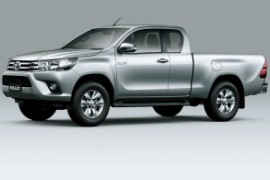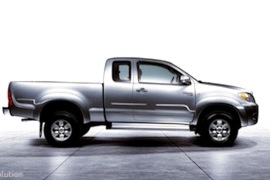TOYOTA Hilux Extra Cab Models/Series Timeline, Specifications & Photos
First production year: 2011
Engines: Diesel
Body style: Truck
The HiLux was one of the most appreciated pickup-trucks in the world for more than half of the century. In 2015, Toyota introduced the eighth generation of the light-utility off-road vehicle.
The recipe for a pickup-truck was quite simple: a bed to load, a cabin to host the driver and its passengers, and an engine in the front. To make it better in off-road conditions, a transfer box and a low range gear completed the main ingredients. The HiLux ticked all the boxes and was offered with a few cab choices.
The HiLux was the best selling pickup-truck in Australia for more than a decade and the 2015 model was brought to keep that sales figures up. It was offered as a single-cab, Extra Cab, and Full-size Cab with four conventional doors. The front end design receives new headlights and a lifted bumper in the front, with two horizontal slats on the grille. The short cabin provided extra room for the bed, where longer items could have been loaded.
The Extra Cab provided a pair of jump-seats in the back, and a pair of half-size suicide doors. But don't expect some comfort for those two places. The extra space in the cabin was a relief for tall drivers, who could tilt their seats backward. The dashboard offered an SUV-like design, with better materials and an option for a 7” infotainment system. It didn't have that basic look of the older models.
One of the reasons why the HiLux was so successful was its reliability and its ruggedness. For the eighth generation if featured a new ladder chassis, stronger than before. For the 2015 model, the HiLux received a new range of engines, with either a 2.4-liter or a 2.8-liter turbodiesel unit. The older 3.0D4-D was retired.
Toyota Hilux was one of the best-known pickups globally, and the carmaker made it available on all continents in a few cab versions.
The Hilux Extra Cab sat in the middle, between the two-seat Single Cab and the family-friendly Crew Cab. It was more than a workhorse, with room for a small team and a more generous bed in the back than the full-size, four-door model.
Unlike its Single Cab sibling, the Extra Cab received more attention from the Japanese carmaker. It sported a body-colored wrapped bumper, where Toyota installed as an option a pair of fog lights. On its sides, the most noticeable difference was the short, pop-out, rear side windows behind the doors. Like its regular-cab sibling, the Extra Cab could carry up to one ton.
Inside, the HiLux Extra Cab featured a pair of bucket seats at the front separated by a center console where Toyota placed the gear selector and the low-range transfer case between the two front occupants. In addition, the carmaker added a pair of jump seats in the back, suitable for short distances due to the limited rear legroom. While the base trim level featured cloth materials and vinyl door-cards, on the upper trim level, the HiLux featured more comfort and amenities such as the heated seats and the automatic transmission.
Under the hood, Toyota installed a choice of inline-four engines ranged between 2.0-liter and 3.0-liter displacement while power ranged between 75 hp and 120 hp.

